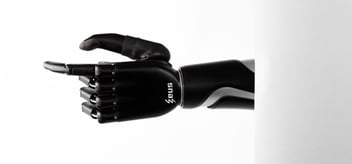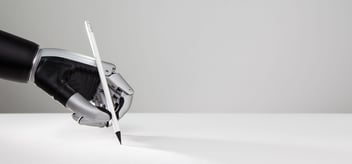Fitting Prostheses to Users: What You Need to Know
Our previous blog delved into the first few steps of the prosthesis process, focusing primarily on the selection process. Once a patient has met with the prosthetic center, undergone a medical assessment, and decided on a prosthetic hand, it’s time for the fitting process to begin.
While it may seem as though the fitting process is simply adjusting the socket to the user’s arm, we will discuss the fitting process in a more holistic manner. For a user’s prosthetic hand to truly be a good “fit,” they must also undergo rehabilitation and training. In doing so, users can learn how to maximize the usage of their prosthesis, ensuring full functionality - something particularly important for users of our device, the Zeus.
Prosthetic Fitting
Once a prosthetic hand has been chosen and training has been discussed, patients are ready to be fitted for their new prosthetic. The care team will create a customized socket for the prosthetic user, ensuring that it fits them comfortably. The socket’s primary function is to support the prosthesis and ensure that it fits the patient.
First-time prosthesis users will likely use a temporary socket and prosthesis for a few months. This is to allow the residual limb time to mature and accommodate to any size changes, in addition to allowing an adjustment period to the weight and feel of the prosthetic hand. For patients that have worn a prosthesis prior, this period will likely only be for a few days to weeks. There are a variety of materials available for a socket, so users should test out different options to determine what is most comfortable for them.
Once a socket is made and fitted to the user, it is time to deliver the prosthetic. The care team will help the patient put on the prosthetic and make any necessary adjustments or modifications. It’s recommended that users reassess their prosthetic fit and function later on in the fitting process. Once the hand is fitted, it is time for training.
Rehabilitation and Training
Rehabilitation and training will differ for each user depending on the type of prosthetic they have chosen. Still, it is necessary for all users so that they can learn how to operate the hand most effectively. Part of the rehabilitation process involves physical therapy, ensuring that users are comfortable wearing and using their new device. Standard practices will include:
- Engaging the grip of the prosthetic hand.
- Holding and picking up objects.
- Practicing standard hand and finger movements.
For users with bionic hands, the care team will help them get trained on their specific device. As bionic hands are controlled by a user’s muscles and supported by advanced technology, there can be a bit of a learning curve when getting adjusted. This is why professionals in the care team will work with patients to teach them individual grips and movements. Users will work with their care team to practice specific movements and grips, ensuring that users will be ready to operate the hand by themselves once training is complete.
Once basic rehabilitation and training are complete and the user is satisfied with their prosthetic hand and ability to use it, the fitting process is finished. That being said, training for one prosthetic hand will be different from another - particularly for bionic hands.
For users with bionic, multi-articulating hands, they will likely begin working with a digital therapy platform from this point forward. In doing so, the user and hand can be monitored and continue the training process to maximize the best outcome for the user. For users interested in our product, we will discuss how we train patients to be users of the Zeus.
Get Trained to be a Zeus User
With our bionic hand, the Zeus, we understand the importance of personalization - but also the learning curve that can come with it. With the Zeus, users can use the hand in tandem with our software to modify individual fingers and grips to best suit their individual needs. We don’t expect users to know how to do this off the bat, which is why we have a four-step plan to get users acquainted with the Zeus.
- Contact us through our website, email, or phone
- Schedule a free trial through your prosthetist
- Get trained to be a Zeus user
Through training with their certified prosthetist/orthotist (CPO), users will not only know how to use their bionic hand properly and safely, but also to maximize its full functionality and potential. CPOs will help users to connect their hand with our software, personally selecting 12 specific finger grips. As such, users can customize their hand grips to their activities and hobbies, whether typing, lifting weights, or adjusting a camera lens.
Once users have adjusted the hand to their liking, they will begin working with a trainer to learn how to control the Zeus. When both user and trainer are satisfied with the user’s use and knowledge of their hand, the process is complete! Users can then begin using the Zeus, ready to face each day with maximized flexibility, strength, dexterity, and control.
If you’re interested in becoming a Zeus user, visit our website and schedule a consolation with one of our experts.










